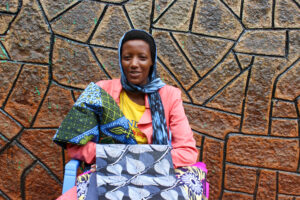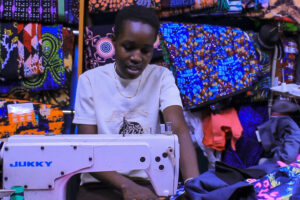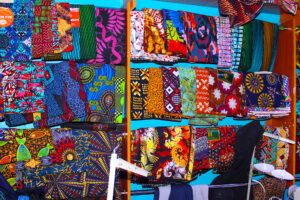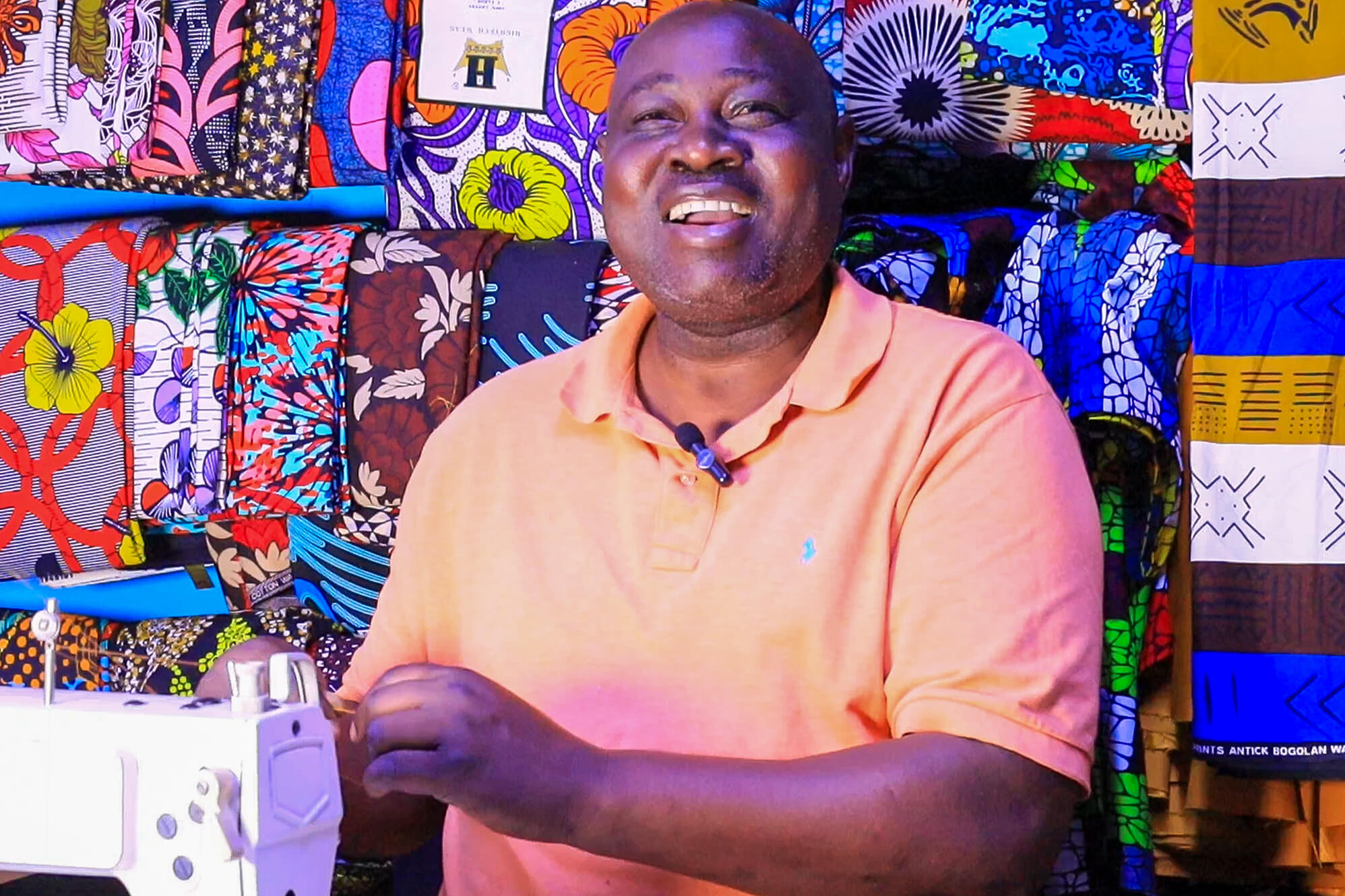By Elizabeth Angira
“Every fabric I use has crossed a border, carrying culture, craft, and connection,” remarked fashion designer Mary Wamboi.
Wamboi received a shipment of earthy Ugandan bark cloth just hours after the arrival of a consignment of vibrant Tanzanian kanga fabrics. The fabrics, along with an order of Kenyan Maasai beads, are for her latest connection.
She described the clothes that she makes as “East African stories.”
“We are building something bigger than ourselves,” she says, “This isn’t just about fashion it is about who we are as a region.”

Wamboi exemplifies the burgeoning cross-border collaboration among players in the East African textile and fashion industry.
This exchange of fashion ideas and products is a benefit of East African Community (EAC) integration policies. Some, enacted many years ago, are now yielding measurable, positive results and churning economic growth.
The East African Community (EAC) is the most integrated regional economic organisation in Africa, according to the Africa Regional Integration Index.
“This integration has created tangible growth,” said George Morara Bw’Akuma, a constitutional and legal matters lawyer practicing in Kisii and Nairobi.
He commented on fashion entrepreneurs reaching new markets beyond major cities like Nairobi and Kampala.
“Designers and traders are now setting up shops in smaller towns such as Mbarara, Entebbe, Mombasa, Nakuru, and Kisii, reflecting vibrant market expansion,” he said.
Bw’Akuma explained that a major success of the EAC has been the harmonization of trade policies and regulatory frameworks.
This, he noted, is a sign of progress.
“When you see policies being reviewed, regulations being aligned across borders, which is the dynamism of integration in action,” he says, “It reflects an evolving system that seeks continuous improvement.”
In the EAC’s emerging cross-border fashion industry, customers have access to various ethnic fabrics.
Agnes Talikwa, a designer from Kenya, spoke on her encounter with the popular kanga fabric of Tanzania.
“My first interaction with the Tanzanian kanga fabric at an Expo in Arusha, Tanzania, ignited my fashion creativity,” she said.

Today, these fabrics are a hallmark of her collections, demonstrating the tangible impact of regional unity on the fashion landscape.
Edward Otieno, a trader in southwestern Kenya, has witnessed the transformation firsthand, having been in the fashion industry for over a decade involving sourcing of kanga and bark cloth from Uganda.
He says that what used to take a week to reach him now takes just two days, due to improved road infrastructure and streamlined customs processes.
“I have seen profits grow, and my network expand beyond borders. Now I do not just trade fabrics, I trade culture,” Otieno said proudly.
Fashion industry insiders confirm a growing number of workers into the sector. The network includes designers, artisans, traders and entrepreneurs.
Joyce Ntugane, a fashion entrepreneur originally from Congo and now based in Kenya, said she is thriving.
“Integration has allowed me to dream bigger,” she said. She plans for regional expansion.
Since moving to Kenya in 2017, the freedom to conduct her business without previous visa restrictions has led to increased customers and profits, with regional fabrics prominently featured in her collections.
Kenyan parliamentarian Dorice Donya, said the EAC adopted several key reforms to support free movement, key among them, the 2009 EAC Common Market Protocol which allows free movement of persons, labour, goods, and services.
“For creatives, this means they can travel more easily to participate in exhibitions, fashion shows, or collaborations without restrictive work permits,” she said.
The EAC Simplified Trade Regime also helps traders, many of whom work in textiles or clothing, to move goods across borders with minimal paperwork and duty exemptions under a certain threshold.
“We are seeing increased regional collaborations between fashion designers, textile producers, and stylists,” she added.
Events like Swahili Fashion Week in Tanzania and Nairobi Fashion Week now host participants from all EAC member states.
The reforms have been pivotal in transforming previously fragmented national markets into a dynamic, interconnected fashion ecosystem.
“Integration has redefined the way I do business,” Wamboi said. “In days gone by, getting materials from Tanzania, Uganda or any other country in the region meant delays and bribes.”
She says that, now, the process is faster, legal, and more affordable giving the players in the fashion value chain access to diverse regional fabrics and techniques thereby enriching the region’s fashion identity and fostering cross-border collaborations that fuse cultural heritage with contemporary design.
Joyce Kemunto, based in southwestern Kenya, attended a fashion workshop in Kampala, Uganda in 2024.
“I soon started getting orders from Uganda and even Tanzania,” she said.

These days, she travels by bus with her clothes and fabrics since the border clearance processes are much easier and one just needs their identity card and a business permit.
“The freedom to move has helped me grow my business and learn new designs from other cultures,” Kemunto added. “We are no longer just ‘village tailors’ we are now East African designers!”
The journey of an elegant garment on a Nairobi runway often involves artisans in Dar es Salaam, Tanzania, models from Kampala, Uganda, and textile traders navigating the Kenya Busia border.
Artisans are also benefiting from consistent work and recognition.
Otieno collaborates with Ugandan bark cloth artisans, incorporating sustainable materials and providing mentorship on adapting traditional techniques for modern fashion.
Ruth Atieno, a fashionista, emphasizes that recent regional policies have dramatically eased artistic collaboration.
“The integration is not just economic, it is cultural since designers are now able to blend elements from different East African cultures to create collections that are both modern and rooted in heritage,” said Atieno.
This cultural fusion is evident in cross-border themed fashion shows and the rise of pan-African trends on social media, forging a distinctive East African fashion identity.
Models now enjoy regional opportunities, supported by agencies and digital platforms that promote cross-border talent, contributing to a shared aesthetic that celebrates diversity and unity.
The African Development Bank (AfDB) says, in Africa, the fashion and textile industry is the second largest sector after agriculture.
“With an estimated market value of USD$31 billion in 2020 it is growing every year. Africa’s fashion industry has the potential to create jobs for millions, especially for women and youth,” AfDB says.
Wamboi’s fashion business has grown significantly, and she now employs interns from Uganda and Tanzania.
Despite the progress, the cross-border fashion industry faces a number of challenges, including uneven border processes, infrastructure gaps, and financing limitations.
Bw’Akuma says despite the milestones, there are persistent barriers to full integration of the region’s creative and fashion industries, key among them, weak enforcement of intellectual property rights (IPRs).
“IPRs belong to its creator,” he explains, “Without proper enforcement across the region, innovators remain vulnerable to exploitation and infringement.”
According to Donya, one of the main challenges is infrastructure and logistics, especially for transporting fashion goods across borders.
“Lack of harmonized customs procedures for creative products, which can delay shipments or cause confusion,” she said.
She also cited the digital barriers such as the differences in mobile payment platforms or inconsistent e-commerce regulations.
“The biggest challenge, however, is intangible, the mindset. We need to encourage more trust, collaboration, and visibility for regional talent so that East Africans can fully support each other’s creative work,” she remarked.
This fashion renaissance celebrates shared history.
“At its core, fashion is about storytelling,” Wamboi concluded.
Donya said the EAC is currently working on a Regional Creative Economy Framework that includes fashion, film, music, and digital arts. One of the focus areas is to continue to ease mobility for creatives, with proposals for a regional artist visa or a creative permit.
“We are also looking into harmonizing taxation on creative products and simplifying cross-border e-commerce systems, which are key for digital fashion sales and brand exposure,” Donya commented.
As the EAC moves towards deeper regional integration, women-led enterprises, designers, and artisanal traders are finding new opportunities for cross-border trade, innovation, and collaboration in fashion and textiles. This transformation is not just about style; it is about stitching livelihoods, culture, and policy together to create a robust regional economy. With bold designs, digital tools, and harmonized trade policies, East Africa’s fashion frontier is being reshaped from the grassroots.
bird story agency
Mary Wamboi, a fashion designer, highlights the growing cross-border collaboration in East African fashion, driven by the integration policies of the East African Community (EAC).
The EAC's efforts in harmonizing trade policies have fostered regional economic growth, enabling designers to access various ethnic fabrics and expand their markets beyond major cities.
This interconnectedness is exemplified by designers and traders setting up operations in smaller towns and by regional events showcasing East African talent.
The integration has significantly benefited the fashion industry, reducing trade barriers and streamlining customs processes. Designers like Agnes Talikwa and Edward Otieno have benefitted from improved infrastructure and quicker access to materials, increasing profits and expanding their cultural networks.
The sector now enjoys easier movement of goods and people thanks to initiatives like the EAC Common Market Protocol and the Simplified Trade Regime, which have facilitated cross-border collaborations and cultural exchanges.
Despite these advancements, challenges remain, such as uneven border processes, infrastructure gaps, and weak enforcement of intellectual property rights.
However, ongoing efforts to further streamline customs, harmonize mobile payment platforms, and digitalize fashion sales continue to enhance the industry's potential.
The EAC is working on a Regional Creative Economy Framework to address these issues, underlining fashion's role in the storytelling of shared East African history and culture.
The fashion sector, largely driven by women-led enterprises, has the potential to significantly impact the region's economy, evidenced by initiatives for more accessible mobility for creatives.
The African Development Bank reports the textile industry's size and potential for job creation, showing that East Africa's fashion frontier is being reshaped by grassroots efforts and regional collaboration.






